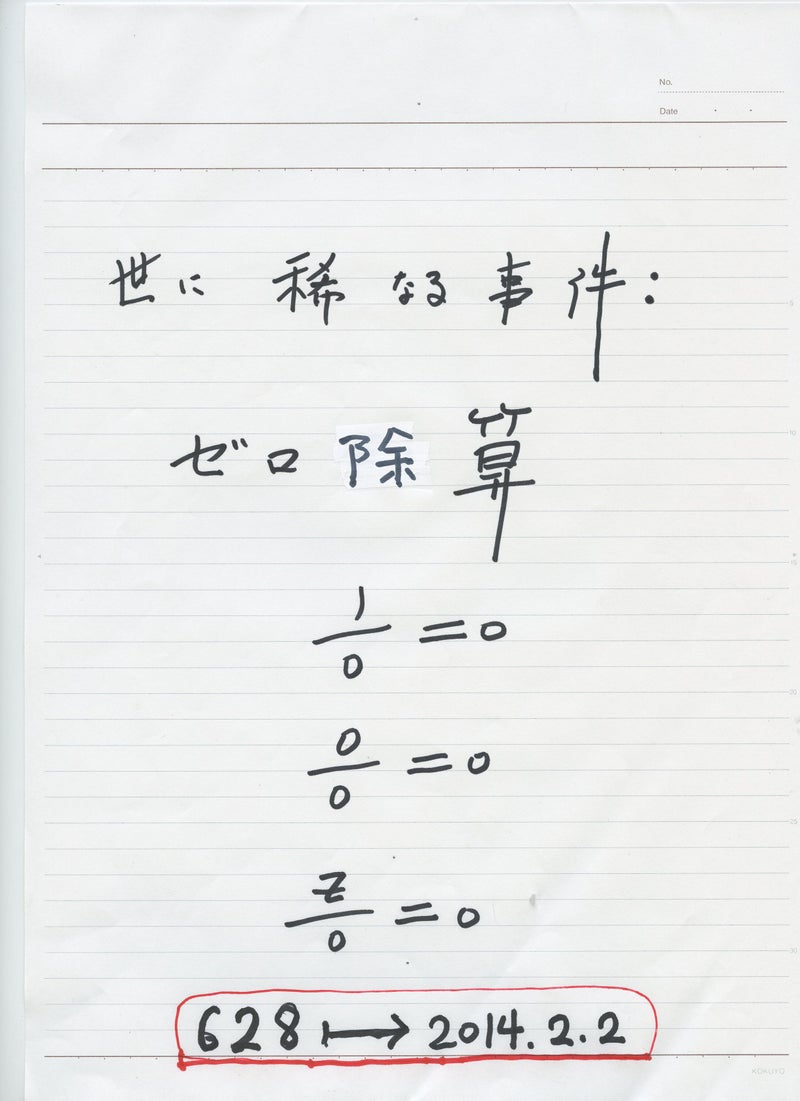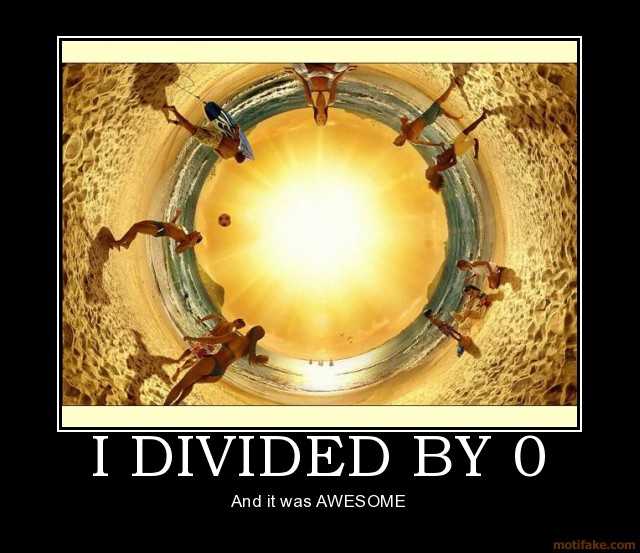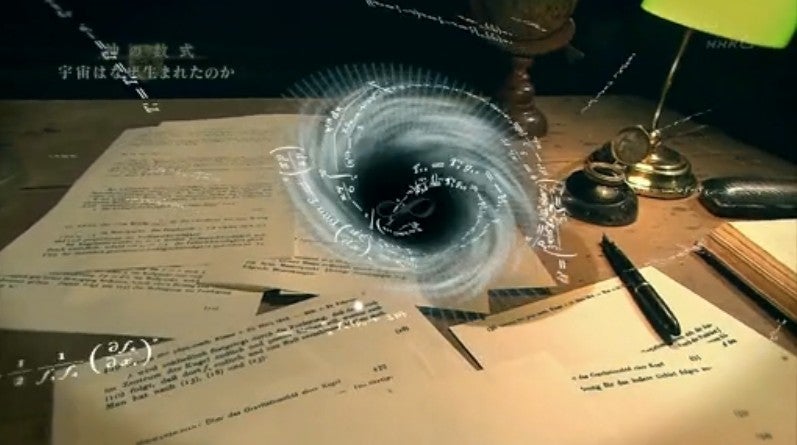Subastan una carta de Albert Einstein disculpándose Sale a subasta una carta de Albert Einstein de 1940. En ella, el científico se disculpaba ante un erudito europeo al que no pudo ayudar a obtener una visa para emigrar a América. Estaba «terriblemente triste» por la desgracia del académico europeo, y alegaba que el becario no era apto para una visa de inmigración fuera de cuota, según informa la revista Live Science.
Aunque Einstein no pudo asistir al solicitante del visado, su implicación en la Segunda Guerra Mundial fue vital para que miles de judíos europeos pudieran escapar de los nazis.Recientemente han aparecido en varias subastas fragmentos de la correspondencia del científico, como las cartas que detallan sus ideas sobre la teoría de la relatividad; su «fórmula secreta para la felicidad»; reflexiones que cuestionan la existencia de Dios; y una dura crítica al apaciguamiento de los nazis por parte del gobierno británico, enviada poco antes de la Segunda Guerra Mundial.
ゼロ除算の発見は日本です:
∞???
∞は定まった数ではない・・・・
人工知能はゼロ除算ができるでしょうか:
とても興味深く読みました:
ゼロ除算の発見と重要性を指摘した:日本、再生核研究所
ゼロ除算関係論文・本
\documentclass[12pt]{article}
\usepackage{latexsym,amsmath,amssymb,amsfonts,amstext,amsthm}
\usepackage{color}
\usepackage{url}
%%%%%%% �}�ԍ��̃J�E���^
\newcounter{num}
\setcounter{num}{0}
%\setcounter{prop}{1}
\newcommand{\Fg}[1][]{\thenum}
\newcommand\Ra{r_{\rm A}}
\numberwithin{equation}{section}
\begin{document}
\title{\bf Announcement 433:\\ Puha's Horn Torus Model for the Riemann Sphere From the Viewpoint of Division by Zero}
\author{
}
\date{2018.07.16}
\maketitle
\newcommand\Al{\alpha}
\newcommand\B{\beta}
\newcommand\De{\delta}
\def\z{\zeta}
\def\rA{r_{\rm A}}
{\bf Abstract: } In this announcement, we will introduce a beautiful horn torus model for the Riemann sphere in complex analysis from the viewpoint of the division by zero based on \cite{ps}.
\medskip
\section{Division by zero calculus and introduction}
The division by zero with mysterious and long history was indeed trivial and clear as in the followings:
\medskip
By the concept of the Moore-Penrose generalized solution of the fundamental equation $ax=b$, the division by zero was trivial and clear all as $a/0=0$ in the {\bf generalized fraction} that is defined by the generalized solution of the equation $ax=b$.
Division by zero is trivial and clear from the concept of repeated subtraction - H. Michiwaki.
Recall the uniqueness theorem by S. Takahasi on the division by zero.
The simple field structure containing division by zero was established by M. Yamada.
Many applications of the division by zero to Wasan geometry were given by H. Okumura.
\medskip
The division by zero opens a new world since Aristotelēs-Euclid.
See the references for recent related results.
As the number system containing the division by zero, the Yamada field structure is complete.
However, for applications of the division by zero to {\bf functions}, we need the concept of the division by zero calculus for the sake of uniquely determinations of the results and for other reasons.
For example, for the typical linear mapping
\begin{equation}
W = \frac{z - i}{z + i},
\end{equation}
it gives a conformal mapping on $\{{\bf C} \setminus \{-i\}\}$ onto $\{{\bf C} \setminus \{1\}\}$ in one to one and from \begin{equation}
W = 1 + \frac{-2i}{ z - (-i)},
\end{equation}
we see that $-i$ corresponds to $1$ and so the function maps the whole $\{{\bf C} \}$ onto $\{{\bf C} \}$ in one to one.
Meanwhile, note that for
\begin{equation}
W = (z - i) \cdot \frac{1}{z + i},
\end{equation}
we should not enter $z= -i$ in the way
\begin{equation}
[(z - i)]_{z =-i} \cdot \left[ \frac{1}{z + i}\right]_{z =-i} = (-2i) \cdot 0= 0 .
\end{equation}
\medskip
However, in many cases, the above two results will have practical meanings and so, we will need to consider many ways for the application of the division by zero and we will need to check the results obtained, in some practical viewpoints. We referred to this delicate problem with many examples.
Therefore, we will introduce the division by zero calculus. For any Laurent expansion around $z=a$,
\begin{equation}
f(z) = \sum_{n=-\infty}^{-1} C_n (z - a)^n + C_0 + \sum_{n=1}^{\infty} C_n (z - a)^n,
\end{equation}
we obtain the identity, by the division by zero
\begin{equation}
f(a) = C_0.
\end{equation}
Note that here, there is no problem on any convergence of the expansion (1.5) at the point $z = a$, because all the terms $(z - a)^n$ are zero at $z=a$ for $n \ne 0$.
\medskip
For the correspondence (1.6) for the function $f(z)$, we will call it {\bf the division by zero calculus}. By considering the formal derivatives in (1.5), we {\bf can define any order derivatives of the function} $f$ at the singular point $a$; that is,
$$
f^{(n)}(a) = n! C_n.
$$
\medskip
{\bf Apart from the motivation, we define the division by zero calculus by (1.6).}
With this assumption, we can obtain many new results and new ideas. However, for this assumption we have to check the results obtained whether they are reasonable or not. By this idea, we can avoid any logical problems. -- In this point, the division by zero calculus may be considered as an axiom.
\medskip
For the fundamental function $W =1/ z $ we did not consider any value at the origin $z = 0$, because we did not consider the division by zero
$1/ 0$ in a good way. Many and many people consider its value by the limiting like $+\infty $ and $- \infty$ or the
point at infinity as $\infty$. However, their basic idea comes from {\bf continuity} with the common sense or
based on the basic idea of Aristotle. --
For the related Greece philosophy, see \cite{a,b,c}. However, as the division by zero we will consider its value of
the function $W =1 /z$ as zero at $z = 0$. We will see that this new definition is valid widely in
mathematics and mathematical sciences, see (\cite{mos,osm}) for example. Therefore, the division by zero will give great impacts to calculus, Euclidian geometry, analytic geometry, complex analysis and the theory of differential equations in an undergraduate level and furthermore to our basic ideas for the space and universe.
For the extended complex plane, we consider its stereographic projection mapping as the Riemann sphere and the point at infinity is realized as the north pole in the Alexsandroff's one point compactification.
The Riemann sphere model gives a beautiful and complete realization of the extended complex plane through the stereographic projection mapping and the mapping has beautiful properties like isogonal (equiangular) and circle to circle correspondence (circle transformation). Therefore, the Riemann sphere is a very classical concept \cite{ahlfors}.
Now, with the division by zero we have to admit the strong discontinuity at the point at infinity.
On this situation, V. Puha discovered the mapping of the extended complex plane to a beautiful horn torus at (2018.6.4.7:22) and its inverse at (2018.6.18.22:18).
Incidentally, independently of the division by zero, Wolfgang W. Daeumler has various special great ideas on horn torus as we see from his site:
\medskip
Horn Torus \& Physics ( https://www.horntorus.com/ ) 'Geometry Of Everything', intellectual game to reveal
engrams of dimensional thinking and proposal for a different approach to physical questions ...
\medskip
Indeed, Wolfgang Daeumler was presumably the first (1996) who came to the idea of the possibility of a mapping onto the horn torus. He expressed the idea of that on his private website (http://www.dorntorus.de). He was also, apparently, the first who to point out that zero and infinity are represented by one and the same point on the horn torus model of expanded complex plane.
\medskip
In this announcement, we will introduce simply the new horn torus model for the classical Riemann sphere from the viewpoint of the division by zero.
\section{Horn torus model}
We will consider the three circles stated by
$$
\xi^2 + \left(\zeta-\frac{1}{2}\right)^2 = \left(\frac{1}{2}\right)^2,
$$
$$
\left(\xi-\frac{1}{4}\right)^2 + \left(\zeta-\frac{1}{2}\right)^2 = \left(\frac{1}{4}\right)^2,
$$
and
$$
\left(\xi+\frac{1}{4}\right)^2 + \left(\zeta-\frac{1}{2}\right)^2 = \left(\frac{1}{4}\right)^2.
$$
By rotation on the space $(\xi,\eta,\zeta)$ on the $(x,y)$ plane as in $\xi =x, \eta=y$ around $\zeta$ axis, we will consider the sphere with $1/2$ radius as the Riemann sphere and the horn torus made in the sphere.
The stereographic projection mapping from $(x,y)$ plane to the Riemann sphere is given by
$$
\xi = \frac{x}{x^2 + y^2 + 1},
$$
$$
\eta = \frac{y}{x^2 + y^2 + 1},
$$
and
$$
\zeta = \frac{x^2 + y^2}{x^2 + y^2 + 1}.
$$
The mapping from $(x,y)$ plane to the horn torus by Puha is given by
$$
\xi = \frac{2x\sqrt{x^2 + y^2}}{(x^2 + y^2 + 1)^2},
$$
$$
\eta = \frac{2y\sqrt{x^2 + y^2}}{(x^2 + y^2 + 1)^2},
$$
and
$$
\zeta = \frac{(x^2 + y^2 -1)\sqrt{x^2 + y^2}}{(x^2 + y^2 + 1)^2} + \frac{1}{2}.
$$
The inversion is given by
$$
x = \xi \left(\xi^2 + \eta^2 + \left(\zeta - \frac{1}{2} \right)^2 -\zeta + \frac{1}{2} \right)^{(-1/2)}
$$
and
$$
y = \eta \left(\xi^2 + \eta^2 + \left(\zeta - \frac{1}{2} \right)^2 -\zeta + \frac{1}{2} \right)^{(-1/2)}.
$$
\section{Properties of horn torus model}
At first, the model shows the strong symmetry of the domains $\{|z|<1\}$ and $\{|z|>1\}$ and they correspond to the lower part and the upper part of the horn torus, respectively. The unit circle $\{|z|=1\}$ corresponds to the circle
$$
\xi^2 + \eta^2 = \left(\frac{1}{2}\right)^2, \quad \zeta = \frac{1}{2}
$$
in one to one way. Of course, the origin and the point at infinity are the same point and correspond to $(0,0,1/2)$. Furthermore,
the inversion relation
$$
z \longleftrightarrow \frac{1}{\overline{z}}
$$
with respect to the unit circle $\{|z|=1\}$ corresponds to the relation
$$
(\xi,\eta,\zeta) \longleftrightarrow (\xi,\eta, 1-\zeta)
$$
and similarly,
$$
z \longleftrightarrow -z
$$
corresponds to the relation
$$
(\xi,\eta,\zeta) \longleftrightarrow (- \xi,-\eta, \zeta)
$$
and
$$
z \longleftrightarrow - \frac{1}{\overline{z}}
$$
corresponds to the relation
$$
(\xi,\eta,\zeta) \longleftrightarrow (-\xi,-\eta, 1-\zeta)
$$
(H.G.W. Begehr: 2018.6.18.19:20).
Furthermore, we can see directly the important properties that the mapping is isogonal (equiangular) and infinitely small circles correspond
to infinitely small circles, as in analytic functions. However, of course, circles to circles mapping property is, in general, not valid as in the case of the stereographic projection mapping.
Horn torus, in contrast to the Riemann sphere, does not satisfy the definition of simply connected space because a closed nonzero path passing through the point $(0,0,1/2)$ can not be continuously shrinked to the point. In particular, note that a curve can pass the point $(0,0,1/2)$ on the horn torus.
We note that only zero and numbers of the form $|a|=1$ have the property : $ |a|^b=|a|, b\ne 0.$
Here, note that we can also consider $0^b =0$ (\cite{mms18}). The symmetry of the horn torus model agrees perfectly with this fact. Only zero and numbers of the form $|a|=1$ correspond to points on the plane described by equation $\zeta -1/2=0$. Only zero and numbers of the form $|a| =1$ correspond to points whose tangent lines to the surface of the horn torus are parallel to the axis $\zeta$.
\section{Conclusion}
The division by zero shows the strong discontinuity at the point at infinity, however, the Riemann sphere model and stereographic projection mapping are fundamental and beautiful.
Many people feel strange feelings for the strong discontinuity that is introduced by the division by zero to the Riemann sphere, however, the strong discontinuity appears in the universe naturally as we see from our new and many concrete results since Euclid.
However, the beautiful horn torus model may be accepted with great pleasures as our space idea. In particular, note that the domains $\{|z|<1\}$ and $\{|z|>1\}$ are completely conformally equivalent and so the completely symmetric property of the corresponding domains on the horn torus is very fine and from this viewpoint, the Riemann sphere model will be curious, in particular, at the point at infinity and the point at infinity will be vague.
\section{Acknowledgements}
The Insitute of Reproducing Kernels wishes to express its deep thanks Professors and colleagues H.G.W. Begehr, Wolfgang W. Daeumler, Hiroshi Okumura, Vyacheslav Puha and Tao Qian for their exciting communications.
\bibliographystyle{plain}
\begin{thebibliography}{10}
\bibitem{ahlfors}
L. V. Ahlfors, Complex Analysis, McGraw-Hill Book Company, 1966.
\bibitem{kmsy}
M. Kuroda, H. Michiwaki, S. Saitoh, and M. Yamane,
New meanings of the division by zero and interpretations on $100/0=0$ and on $0/0=0$,
Int. J. Appl. Math. {\bf 27} (2014), no 2, pp. 191-198, DOI: 10.12732/ijam.v27i2.9.
\bibitem{ms16}
T. Matsuura and S. Saitoh,
Matrices and division by zero $z/0=0$,
Advances in Linear Algebra \& Matrix Theory, {\bf 6}(2016), 51-58
Published Online June 2016 in SciRes. http://www.scirp.org/journal/alamt
\\ http://dx.doi.org/10.4236/alamt.2016.62007.
\bibitem{mms18}
T. Matsuura, H. Michiwaki and S. Saitoh,
$\log 0= \log \infty =0$ and applications. Differential and Difference Equations with Applications. Springer Proceedings in Mathematics \& Statistics. {\bf 230} (2018), 293-305.
\bibitem{msy}
H. Michiwaki, S. Saitoh and M.Yamada,
Reality of the division by zero $z/0=0$. IJAPM International J. of Applied Physics and Math. {\bf 6}(2015), 1--8. http://www.ijapm.org/show-63-504-1.html
\bibitem{mos}
H. Michiwaki, H. Okumura and S. Saitoh,
Division by Zero $z/0 = 0$ in Euclidean Spaces,
International Journal of Mathematics and Computation, {\bf 2}8(2017); Issue 1, 1-16.
\bibitem{osm}
H. Okumura, S. Saitoh and T. Matsuura, Relations of $0$ and $\infty$,
Journal of Technology and Social Science (JTSS), {\bf 1}(2017), 70-77.
\bibitem{os}
H. Okumura and S. Saitoh, The Descartes circles theorem and division by zero calculus. https://arxiv.org/abs/1711.04961 (2017.11.14).
\bibitem{o}
H. Okumura, Wasan geometry with the division by 0. https://arxiv.org/abs/1711.06947 International Journal of Geometry.
\bibitem{os18april}
H. Okumura and S. Saitoh,
Harmonic Mean and Division by Zero,
Dedicated to Professor Josip Peˇ cari´c on the occasion of his 70th birthday, Forum Geometricorum, {\bf 18} (2018), 155—159.
\bibitem{os18}
H. Okumura and S. Saitoh,
Remarks for The Twin Circles of Archimedes in a Skewed Arbelos by H. Okumura and M. Watanabe, Forum Geometricorum, {\bf 18}(2018), 97-100.
\bibitem{os18e}
H. Okumura and S. Saitoh,
Applications of the division by zero calculus to Wasan geometry.
GLOBAL JOURNAL OF ADVANCED RESEARCH ON CLASSICAL AND MODERN GEOMETRIES” (GJARCMG)(in press).
\bibitem{ps18}
S. Pinelas and S. Saitoh,
Division by zero calculus and differential equations. Differential and Difference Equations with Applications. Springer Proceedings in Mathematics \& Statistics. {\bf 230} (2018), 399-418.
\bibitem{ps}
V. Puha and S. Saitoh,
Horn Torus Model for the Riemann Sphere From the Viewpoint of Division by Zero (manuscript).
\bibitem{s14}
S. Saitoh, Generalized inversions of Hadamard and tensor products for matrices, Advances in Linear Algebra \& Matrix Theory. {\bf 4} (2014), no. 2, 87--95. http://www.scirp.org/journal/ALAMT/
\bibitem{s16}
S. Saitoh, A reproducing kernel theory with some general applications,
Qian,T./Rodino,L.(eds.): Mathematical Analysis, Probability and Applications - Plenary Lectures: Isaac 2015, Macau, China, Springer Proceedings in Mathematics and Statistics, {\bf 177}(2016), 151-182. (Springer)
\bibitem{s17}
S. Saitoh, Mysterious Properties of the Point at Infinity, arXiv:1712.09467 [math.GM](2017.12.17).
\bibitem{s18}
S. Saitoh, Division by zero calculus (189 pages): http//okmr.yamatoblog.net/
\bibitem{ttk}
S.-E. Takahasi, M. Tsukada and Y. Kobayashi, Classification of continuous fractional binary operations on the real and complex fields, Tokyo Journal of Mathematics, {\bf 38}(2015), no. 2, 369-380.
\bibitem{a}
https://philosophy.kent.edu/OPA2/sites/default/files/012001.pdf
\bibitem{b}
http://publish.uwo.ca/~jbell/The 20Continuous.pdf
\bibitem{c}
http://www.mathpages.com/home/kmath526/kmath526.htm
\end{thebibliography}
\end{document}








































0 件のコメント:
コメントを投稿